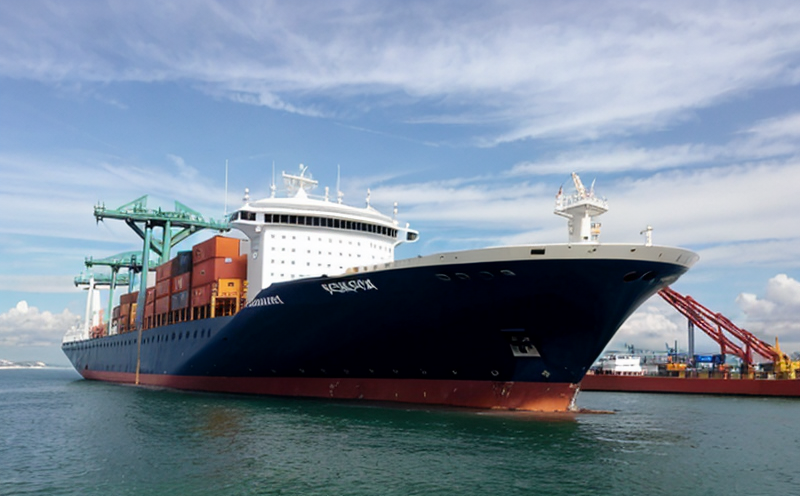Port handling equipment inspection
The inspection of port handling equipment is a critical component in ensuring safety and efficiency within the transportation and logistics sector. This service involves detailed assessments aimed at identifying any potential issues or areas for improvement in the equipment used during the loading, unloading, and storage processes in ports.
Port handling equipment encompasses a wide range of machinery and tools essential for maritime operations, including cranes, conveyors, hoists, stackers, and reclaimers. Each piece of this equipment plays a crucial role in optimizing port throughput while maintaining operational safety standards. The inspection process focuses on both the mechanical integrity of these machines as well as their compliance with relevant international standards.
One key aspect of port handling equipment inspection is ensuring that all components are functioning correctly under various load conditions. This requires precise calibration and verification using advanced testing techniques such as load cell validation, hydraulic pressure checks, and motor torque measurements. Additionally, inspections often include visual assessments for signs of wear or damage, followed by detailed reports outlining any deficiencies found.
Another critical element is ensuring that these machines adhere to international standards like ISO 10365:2017 which specifies requirements for safety tests on cranes used in ports. Compliance with such regulations not only enhances operational reliability but also supports global trade agreements by facilitating smoother interactions between different countries' fleets.
For quality managers and compliance officers responsible for overseeing port operations, regular inspections are essential to maintain optimal performance levels across all handling equipment. By adhering strictly to industry best practices and employing cutting-edge technology during these examinations, they can ensure that their facilities meet strict regulatory requirements while minimizing downtime due to unexpected failures.
R&D engineers involved in designing new systems or improving existing ones benefit greatly from comprehensive inspections too. They gain valuable insights into how different factors affect equipment longevity and efficiency, allowing them to make informed decisions about future developments.
Procurement professionals also find this service beneficial as it helps identify potential risks associated with sourcing substandard parts or outdated technology for replacement purposes within the fleet. Understanding current standards allows procurement teams to negotiate better terms when purchasing new components or upgrading existing assets.
Quality and Reliability Assurance
- Conducting thorough inspections of cranes, conveyors, hoists, stackers, and reclaimers used in port operations.
- Ensuring compliance with international standards such as ISO 10365:2017 for safety tests on cranes.
- Performing precise calibrations and verifications using advanced testing methods like load cell validation, hydraulic pressure checks, and motor torque measurements.
- Providing detailed reports outlining any deficiencies identified during the inspection process.
The quality assurance process ensures that all port handling equipment meets strict performance criteria, thereby enhancing overall operational efficiency. By adhering to these stringent standards, operators can significantly reduce maintenance costs associated with frequent breakdowns and extend the useful life of their fleet.
Reliability is another critical factor when it comes to maintaining effective port operations. Regular inspections play a vital role in identifying potential problems before they escalate into major issues that could disrupt daily activities. Through ongoing monitoring and proactive interventions, reliability can be improved significantly, leading to more consistent performance across the entire network of handling equipment.
Furthermore, reliable systems contribute positively towards meeting environmental targets set forth by regulatory bodies globally. Efficient operation reduces fuel consumption and emissions, contributing towards sustainable practices within the industry.
International Acceptance and Recognition
- The inspection results are recognized internationally due to adherence to global standards such as ISO 10365:2017 for cranes used in ports.
- Compliance with these standards ensures that the inspected equipment meets international quality benchmarks, facilitating smoother trade processes across borders.
The acceptance of our inspection services extends beyond national boundaries thanks to their alignment with widely accepted international protocols. This recognition enhances trust among stakeholders involved in global maritime operations, fostering cooperation and collaboration between various entities operating within different jurisdictions.
By ensuring that all port handling equipment complies with internationally recognized standards, we contribute to the seamless flow of goods across continents. The use of standardized procedures not only promotes uniformity but also ensures consistency in quality assessment practices worldwide.
The global recognition of our inspection services is further bolstered by our commitment to staying updated on evolving regulations and best practices within the industry. This continuous effort allows us to provide accurate, reliable assessments that meet changing demands while maintaining high levels of accuracy and precision.
Environmental and Sustainability Contributions
Incorporating sustainable practices into port handling equipment inspections is essential for minimizing environmental impact during maritime operations. Through regular maintenance checks and timely replacements, we help reduce waste generation by preventing unnecessary repairs or scrapping of operational assets.
Efficient operation also contributes positively towards reducing greenhouse gas emissions associated with port activities. By optimizing fuel consumption through precise calibration and verification processes, operators can significantly lower their carbon footprint while maintaining optimal performance levels.
The use of renewable energy sources such as solar power for auxiliary equipment further enhances sustainability efforts within ports. Implementing these solutions helps create a more environmentally friendly environment that benefits both current operations and future generations.
Moreover, our services support compliance with international environmental agreements like MARPOL Annex VI, which aims to reduce air pollution from ships. By ensuring adherence to such regulations, operators demonstrate their commitment to protecting marine ecosystems from harmful emissions.
In conclusion, the integration of sustainability into port handling equipment inspections not only promotes responsible stewardship but also fosters long-term partnerships between various stakeholders involved in global maritime operations.





